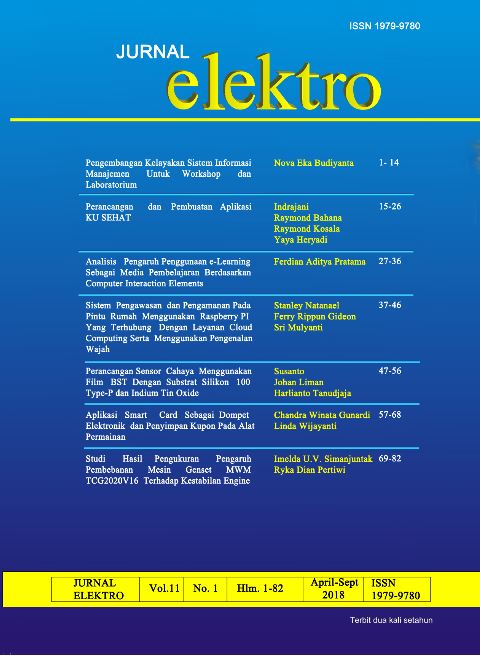ANALISIS PENGARUH PENGGUNAAN E-LEARNING SEBAGAI MEDIA PEMBELAJARAN BERDASARKAN HUMAN COMPUTER INTERACTION ELEMENTS (STUDI KASUS: UAJ)
Keywords:
Human Computer Interaction Elements, e-learning, usability, user experienceAbstract
ABSTRAK
Masuknya teknologi dalam dunia pendidikan sangatlah mempengaruhi proses belajar mengajar yang terjadi di dalam suatu perguruan tinggi. E-learning adalah salah satu contoh teknologi yang digunakan oleh perguruan tinggi untuk mengikuti perkembangan teknologi dalam dunia pendidikan saat ini. E-learning betujuan untuk membantu memudahkan mahasiswa memahami materi yang diberikan oleh dosen ataupun mengumpulkan tugas dan kuis yang diberikan. Penerapan e-learning menimbulkan sebuah interaksi yang terjadi antara pengguna/user dengan sistem/komputer. Untuk melihat pengaruh interaksi dalam penggunaan e-learning tersebut, digunakan beberapa indikator berdasarkan human computer interaction elements. Tujuan dari penelitian ini adalah untuk mengetahui seberapa besar pengaruh penggunaan e-learning terhadap proses kegiatan belajar mahasiswa dilihat berdasarkan interaksi yang terjadi. Penelitian ini menghasilkan sebuah informasi bahwa e-learning yang digunakan saat ini sudah sesuai dengan seharusnya. Namun, kecilnya perbedaan persentase tersebut menunjukkan bahwa e-learning yang digunakan saat ini belum sepenuhnya efektif (66.25%), efisien (64%%), dan mudah untuk dipelajari oleh pengguna (75.3%). Sedangkan dari sisi users experience, e-learning yang digunakan saat ini sudah cukup membantu para mahasiswa untuk mendapatkan materi atau mengumpulkan tugas dari manapun (62.66%), memiliki tampilan yang mudah untuk dipelajari, enak untuk dilihat, dan user friendly (91,3%). Namun, penggunaan e-learning belum cukup membantu para mahasiswa untuk bisa mendapatkan nilai yang tinggi di dalam kelas.
ABSTRACT
Technology in education is greatly affect the teaching and learning process that happen in university. E-learning is one of the example of technology that university used to keep up with technology in education. The purpose of e-learning is to help every student understand the lecture or help them to turn-in the assignment easily. The use of e-learning means there is an interaction happen between human and computer. There are some of human computer interaction elements used to see the impact of e-learning interaction. The purpose of this research is to know how influence the impact of e-learning in teaching and learning process based on the interaction that happen. The result from this research is an information that the used E-learning today is appropriate. However, the small percentage difference indicates that the E-learning currently used is not fully effective (66.25%), efficient (64%), and not easy for users to learn about it (75.3%). And for the user’s experience elements, the used E-learning today is already good enough to help the student accessing the lecture and turning in the assignment everywhere (62.66%), and it has a user friendly interface. However, the used E-learning today is not helpful enough for student to get a good grade.
References
[2] Mejía, A. e. (2012). Implementing adaptive interfaces: a user model for the development of usability in interactive systems. Proceedings of the CUBE International Information Technology Conference. ACM.
[3] Chae, S. W., Lee, K. C., & Seo3, Y. W. (2016). Exploring the Effect of Avatar Trust on Learners’ Perceived Participation Intentions in an e-Learning Environment. Intl. Journal of Human–Computer Interaction, 373–393.
[4] D, N. (2009). Korea Tries to Level the Field. Science, 323(5910). 62-63.
[5] Majid, R., Abd, N., & al, e. (2011). Users’ Frustration and HCI in the Software Development Life Cycle. International Journal Of Information Processing and Management.
[6] Nunes, F., Silva, P. A., & Abrantes, F. (2010). Human-computer interaction and the older adult: an example using user research and personas. Proceedings of the 3rd International Conference on PErvasive Technologies Related to Assistive Environments. ACM.
[7] Fallman, Daniel. "The new good: exploring the potential of philosophy of technology to contribute to human-computer interaction." Proceedings of the SIGCHI Conference on Human Factors in Computing Systems. ACM, 2011.
[8] Hasnine, M. N., Chayon, M. K. H., & Rahman, M. M. (2015). A Cost Effective Approach to Develop Mid-size Enterprise Software Adopted the Waterfall Model. World Academy of Science, Engineering and Technology, International Journal of Computer, Electrical, Automation, Control and Information Engineering, 9(5), 1140-1149.
[9] Majid,Rogayah Abdul., Noor,Nor Laila Md., Adnan,Wan Adilah Wan.2010.A survey on user involvement in software develpoment life cycle from practitioner's perspectives. Computer Science and Convergence Information Technology (ICCIT), pp.240-243, 2010.
[10] Shiau,Wen-Lung., Yan,Chang-Ming., Kuo,Chen-Chao.2016.The Intellectual Structure of Human Computer Interaction Research. Journal of Information Science & Engineering, vol.32, pp.703-730.
[11] Kim, J. W. (2012). Human Computer Interaction. Ahn graphics
[12] Sims, J., Vidgen, R., & Powell, P. (2008). E-learning and the digital divide: Perpetuating cultural and socio-economic elitism in higher education. Communications of the Association for Information Systems, 22(23), 429–442.
[13] Martínez-Torres, M., Toral, S., & Barrero, F. (2011). Identification of the design variables of eLearning tools. Interacting with Computers, 23(3), 279–288.
[14] Zamfiroiu, A., & Sbora, C. (2014). Statistical analysis of the behavior for mobile E-learning.Procedia Economics and Finance, 10, 237–243.
[15] Urh, M., & Jereb, J.(2014). Learning habits in higher education.Procedia-Social and Behavioral Sciences, 116, 350–355.
[16] Fauzi, Muchammad. Metode Penelitian Kuantitatif, Semarang : Walisongo, 2009.
[17] Ghozali, I and Fuad, Structural Equation Modeling: Teori, Konsep, dan Aplikasi, Semarang: Badan Penerbit Universitas Diponegoro, 2005.



